List of Caprimulgiformes by population
| The population of birds |
|---|
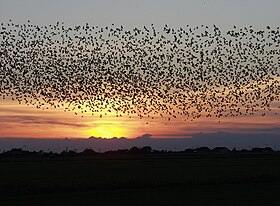 |
This is a list of Caprimulgiformes species by global population. While numbers are estimates, they have been made by the experts in their fields. For more information on how these estimates were ascertained, see Wikipedia's articles on population biology and population ecology.
This list is not comprehensive, as not all Caprimulgiformes have had their numbers quantified.
Species by global population
| Common name | Binomial name | Population | Status | Trend | Notes | Image |
|---|---|---|---|---|---|---|
| New Caledonian owlet-nightjar | Aegotheles savesi | 1-49[1] | CR[1] | The most recent sighting is in 1998.[1] | 
| |
| New Caledonian nightjar | Eurostopodus exul | 1-49[2] | CR[2] | ?[2] | There is only one specimen ever taken in 1939.[2] | |
| Jamaican poorwill | Siphonorhis americana | 1-49[3] | CR[3] | ?[3] | No records since 1860.[3] | 
|
| White-winged nightjar | Eleothreptus candicans | 600-1,700[4] | VU[4] | Actual population may be larger.[4] | 
| |
| Puerto Rican nightjar | Caprimulgus noctitherus | 930-1,300[5] | EN[5] | This estimate is based on 712 males found within a portion of its range.[5] | 
| |
| Solomons nightjar | Eurostopodus nigripennis | 1,000-2,499[6] | VU[6] | Estimate from lack of records and species small range.[6] | 
| |
| Palau nightjar | Caprimulgus phalaena | 1,000-2,499[7] | NT[7] | Preliminary estimate.[7] | ||
| Prigogine's nightjar | Caprimulgus prigoginei | 2,500-9,999[8] | EN[8] | Estimate comes from consideration of habitat and last recorded specimen was in 1955.[8] | ||
| Satanic nightjar | Eurostopodus diabolicus | 2,500-9,999[9] | VU[9] | 
| ||
| Sickle-winged nightjar | Eleothreptus anomalus | 2,500-52,000[10] | VU[10] | Large population variation is due to the common appearances, but apparent scarcity of the species (i.e. they are mostly nocturnal, which makes observing them harder, and they often only a lone individual is sighted).[10] | ||
| Least poorwill | Siphonorhis brewsteri | 4,140[11] | NT[11] | Estimate is calculated from population density and available habitat.[11] | ||
| Salvadori's nightjar | Caprimulgus pulchellus | 6,000-15,000[12] | NT[12] | Estimate comes from limited available habitat.[12] | ||
| Bonaparte's nightjar | Caprimulgus concretus | 10,000-19,999[13] | VU[13] | Preliminary estimate.[13] | 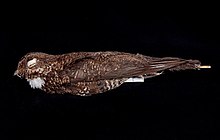
| |
| Choco poorwill | Nyctiphrynus rosenbergi | 10,000-19,999[14] | LC[14] | Preliminary estimate.[14] | 
| |
| Eared poorwill | Nyctiphrynus mcleodii | 20,000-49,999[15] | LC[15] | |||
| Yucatan poorwill | Nyctiphrynus yucatanicus | 20,000-49,999[16] | LC[16] | 
| ||
| Dusky nightjar | Antrostomus saturatus | 20,000-49,999[17] | LC[17] | 
| ||
| Short-tailed nighthawk | Lurocalis semitorquatus | 50,000-499,999[18] | LC[18] | 
| ||
| Spot-tailed nightjar | Caprimulgus maculicaudus | 50,000-499,999[19] | LC[19] | 
| ||
| Yucatan nightjar | Caprimulgus badius | 50,000-499,999[20] | LC[20] | |||
| Tawny-collared nightjar | Antrostomus salvini | 50,000-499,999[21] | LC[21] | 
| ||
| Antillean nighthawk | Chordeiles gundlachii | 200,000[22] | LC[22] | 
| ||
| Mexican whip-poor-will | Antrostomus arizonae | 320,000[23] | LC[23] | 
| ||
| White-tailed nightjar | Hydropsalis cayennensis | 500,000-4,999,999[24] | LC[24] | 
| ||
| Ocellated poorwill | Nyctiphrynus ocellatus | 500,000-4,999,999[25] | LC[25] | 
| ||
| Red-necked nightjar | Caprimulgus ruficollis | 575,000-770,000[26] | NT[26] | Consists of two subspecies, so these estimates are very preliminary.[26] | 
| |
| Common poorwill | Phalaenoptilus nuttallii | 1,700,000[27] | LC[27] | 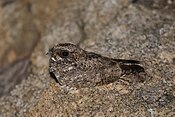
| ||
| Eastern whip-poor-will | Antrostomus vociferus | 1,800,000[28] | NT[28] | 
| ||
| Buff-collared nightjar | Antrostomus ridgwayi | 2,000,000[29] | LC[29] | 
| ||
| European nightjar | Caprimulgus europaeus | 3,000,000-5,999,999[30] | LC[30] | European population estimated at 1,230,000-2,200,000, so very preliminary estimate of global population.[30] | 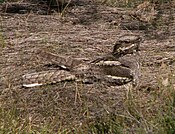
| |
| Rufous nightjar | Antrostomus rufus | 5,000,000-49,999,999[31] | LC[31] | 
| ||
| Chuck-will's-widow | Antrostomus carolinensis | 5,700,000[32] | NT[32] | 
| ||
| Pauraque | Nyctidromus albicollis | 20,000,000[33] | LC[33] | 
| ||
| Common nighthawk | Chordeiles minor | 23,000,000[34] | LC[34] | 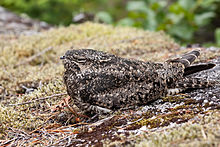
|
See also
References
- ^ a b c d IUCN (2016-10-01). "Aegotheles savesi: BirdLife International: The IUCN Red List of Threatened Species 2018: e.T22689559A129328996". IUCN Red List of Threatened Species. 2016-10-01. doi:10.2305/iucn.uk.2016-3.rlts.t22689559a129328996.en.
- ^ a b c d IUCN (2018-08-07). "Eurostopodus exul: BirdLife International: The IUCN Red List of Threatened Species 2018: e.T22726340A130437059". IUCN Red List of Threatened Species. 2018-08-07. doi:10.2305/iucn.uk.2018-2.rlts.t22726340a130437059.en.
- ^ a b c d IUCN (2020-08-31). "Siphonorhis americana: BirdLife International: The IUCN Red List of Threatened Species 2020: e.T22689738A178420953". IUCN Red List of Threatened Species. 2020-08-31. doi:10.2305/iucn.uk.2020-3.rlts.t22689738a178420953.en.
- ^ a b c d IUCN (2019-07-05). "Eleothreptus candicans: BirdLife International: The IUCN Red List of Threatened Species 2019: e.T22689826A153953594". IUCN Red List of Threatened Species. 2019-07-05. doi:10.2305/iucn.uk.2019-3.rlts.t22689826a153953594.en.
- ^ a b c d IUCN (2016-10-01). "Antrostomus noctitherus: BirdLife International: The IUCN Red List of Threatened Species 2016: e.T22689809A93248623". IUCN Red List of Threatened Species. 2016-10-01. doi:10.2305/iucn.uk.2016-3.rlts.t22689809a93248623.en.
- ^ a b c d IUCN (2016-10-01). "Eurostopodus nigripennis: BirdLife International: The IUCN Red List of Threatened Species 2016: e.T22725672A94899076". IUCN Red List of Threatened Species. 2016-10-01. doi:10.2305/iucn.uk.2016-3.rlts.t22725672a94899076.en.
- ^ a b c d IUCN (2016-10-01). "Caprimulgus phalaena: BirdLife International: The IUCN Red List of Threatened Species 2016: e.T22726346A94919653". IUCN Red List of Threatened Species. 2016-10-01. doi:10.2305/iucn.uk.2016-3.rlts.t22726346a94919653.en.
- ^ a b c d IUCN (2016-10-01). "Caprimulgus prigoginei: BirdLife International: The IUCN Red List of Threatened Species 2016: e.T22689954A93253760". IUCN Red List of Threatened Species. 2016-10-01. doi:10.2305/iucn.uk.2016-3.rlts.t22689954a93253760.en.
- ^ a b c IUCN (2016-10-01). "Eurostopodus diabolicus: BirdLife International: The IUCN Red List of Threatened Species 2017: e.T22689670A110061123". IUCN Red List of Threatened Species. 2016-10-01. doi:10.2305/iucn.uk.2017-1.rlts.t22689670a110061123.en.
- ^ a b c d IUCN (2021-02-15). "Eleothreptus anomalus: BirdLife International: The IUCN Red List of Threatened Species 2021: e.T22690056A196567064". IUCN Red List of Threatened Species. 2021-02-15. doi:10.2305/iucn.uk.2021-3.rlts.t22690056a196567064.en.
- ^ a b c d IUCN (2021-03-23). "Siphonorhis brewsteri: BirdLife International: The IUCN Red List of Threatened Species 2021: e.T22689751A178049869". IUCN Red List of Threatened Species. 2021-03-23. doi:10.2305/iucn.uk.2021-3.rlts.t22689751a178049869.en.
- ^ a b c d IUCN (2016-10-01). "Caprimulgus pulchellus: BirdLife International: The IUCN Red List of Threatened Species 2017: e.T22689997A111018453". IUCN Red List of Threatened Species. 2016-10-01. doi:10.2305/iucn.uk.2017-1.rlts.t22689997a111018453.en.
- ^ a b c d IUCN (2016-10-01). "Caprimulgus concretus: BirdLife International: The IUCN Red List of Threatened Species 2017: e.T22689993A110103017". IUCN Red List of Threatened Species. 2016-10-01. doi:10.2305/iucn.uk.2017-1.rlts.t22689993a110103017.en.
- ^ a b c d IUCN (2021-11-10). "Nyctiphrynus rosenbergi: BirdLife International: The IUCN Red List of Threatened Species 2022: e.T22724499A210613156". IUCN Red List of Threatened Species. 2021-11-10. doi:10.2305/iucn.uk.2022-1.rlts.t22724499a210613156.en.
- ^ a b c IUCN (2019-12-03). "Nyctiphrynus mcleodii: BirdLife International: The IUCN Red List of Threatened Species 2020: e.T22689755A163503384". IUCN Red List of Threatened Species. 2019-12-03. doi:10.2305/iucn.uk.2020-3.rlts.t22689755a163503384.en.
- ^ a b c IUCN (2019-12-03). "Nyctiphrynus yucatanicus: BirdLife International: The IUCN Red List of Threatened Species 2020: e.T22689767A163503956". IUCN Red List of Threatened Species. 2019-12-03. doi:10.2305/iucn.uk.2020-3.rlts.t22689767a163503956.en.
- ^ a b c IUCN (2019-12-03). "Antrostomus saturatus: BirdLife International: The IUCN Red List of Threatened Species 2020: e.T22689813A163507700". IUCN Red List of Threatened Species. 2019-12-03. doi:10.2305/iucn.uk.2020-3.rlts.t22689813a163507700.en.
- ^ a b c IUCN (2019-12-03). "Lurocalis semitorquatus: BirdLife International: The IUCN Red List of Threatened Species 2020: e.T22689695A163501030". IUCN Red List of Threatened Species. 2019-12-03. doi:10.2305/iucn.uk.2020-3.rlts.t22689695a163501030.en.
- ^ a b c IUCN (2019-12-03). "Hydropsalis maculicaudus: BirdLife International: The IUCN Red List of Threatened Species 2020: e.T22689847A163510493". IUCN Red List of Threatened Species. 2019-12-03. doi:10.2305/iucn.uk.2020-3.rlts.t22689847a163510493.en.
- ^ a b c IUCN (2019-12-03). "Antrostomus badius: BirdLife International: The IUCN Red List of Threatened Species 2020: e.T22689795A163506971". IUCN Red List of Threatened Species. 2019-12-03. doi:10.2305/iucn.uk.2020-3.rlts.t22689795a163506971.en.
- ^ a b c IUCN (2019-12-03). "Antrostomus salvini: BirdLife International: The IUCN Red List of Threatened Species 2020: e.T22689792A163506180". IUCN Red List of Threatened Species. 2019-12-03. doi:10.2305/iucn.uk.2020-3.rlts.t22689792a163506180.en.
- ^ a b c IUCN (2020-02-19). "Chordeiles gundlachii: BirdLife International: The IUCN Red List of Threatened Species 2020: e.T22689717A168858532". IUCN Red List of Threatened Species. 2020-02-19. doi:10.2305/iucn.uk.2020-3.rlts.t22689717a168858532.en.
- ^ a b c IUCN (2020-02-19). "Antrostomus arizonae: BirdLife International: The IUCN Red List of Threatened Species 2020: e.T22736398A152272957". IUCN Red List of Threatened Species. 2020-02-19. doi:10.2305/iucn.uk.2020-3.rlts.t22736398a152272957.en.
- ^ a b c IUCN (2019-12-03). "Hydropsalis cayennensis: BirdLife International: The IUCN Red List of Threatened Species 2020: e.T22689823A163509463". IUCN Red List of Threatened Species. 2019-12-03. doi:10.2305/iucn.uk.2020-3.rlts.t22689823a163509463.en.
- ^ a b c IUCN (2019-12-03). "Nyctiphrynus ocellatus: BirdLife International: The IUCN Red List of Threatened Species 2020: e.T22689773A163504499". IUCN Red List of Threatened Species. 2019-12-03. doi:10.2305/iucn.uk.2020-3.rlts.t22689773a163504499.en.
- ^ a b c d IUCN (2022-03-30). "Caprimulgus ruficollis: BirdLife International: The IUCN Red List of Threatened Species 2022: e.T22689875A211192401". IUCN Red List of Threatened Species. 2022-03-30. doi:10.2305/iucn.uk.2022-1.rlts.t22689875a211192401.en.
- ^ a b c IUCN (2020-11-04). "Phalaenoptilus nuttallii: BirdLife International: The IUCN Red List of Threatened Species 2021: e.T22689735A189013377". IUCN Red List of Threatened Species. 2020-11-04. doi:10.2305/iucn.uk.2021-3.rlts.t22689735a189013377.en.
- ^ a b c IUCN (2019-06-12). "Antrostomus vociferus: BirdLife International: The IUCN Red List of Threatened Species 2021: e.T22736393A152619806". IUCN Red List of Threatened Species. 2019-06-12. doi:10.2305/iucn.uk.2021-3.rlts.t22736393a152619806.en.
- ^ a b c IUCN (2020-02-19). "Antrostomus ridgwayi: BirdLife International: The IUCN Red List of Threatened Species 2020: e.T22689801A168861529". IUCN Red List of Threatened Species. 2020-02-19. doi:10.2305/iucn.uk.2020-3.rlts.t22689801a168861529.en.
- ^ a b c d IUCN (2016-10-01). "Caprimulgus europaeus: BirdLife International: The IUCN Red List of Threatened Species 2016: e.T22689887A86103675". IUCN Red List of Threatened Species. 2016-10-01. doi:10.2305/iucn.uk.2016-3.rlts.t22689887a86103675.en.
- ^ a b c IUCN (2019-12-03). "Antrostomus rufus: BirdLife International: The IUCN Red List of Threatened Species 2020: e.T22689781A163505520". IUCN Red List of Threatened Species. 2019-12-03. doi:10.2305/iucn.uk.2020-3.rlts.t22689781a163505520.en.
- ^ a b c IUCN (2020-08-31). "Antrostomus carolinensis: BirdLife International: The IUCN Red List of Threatened Species 2020: e.T22689778A154067182". IUCN Red List of Threatened Species. 2020-08-31. doi:10.2305/iucn.uk.2020-3.rlts.t22689778a154067182.en.
- ^ a b c IUCN (2020-02-19). "Nyctidromus albicollis: BirdLife International: The IUCN Red List of Threatened Species 2020: e.T22689731A168860360". IUCN Red List of Threatened Species. 2020-02-19. doi:10.2305/iucn.uk.2020-3.rlts.t22689731a168860360.en.
- ^ a b c IUCN (2020-11-04). "Chordeiles minor: BirdLife International: The IUCN Red List of Threatened Species 2021: e.T22689714A189010894". IUCN Red List of Threatened Species. 2020-11-04. doi:10.2305/iucn.uk.2021-3.rlts.t22689714a189010894.en.

